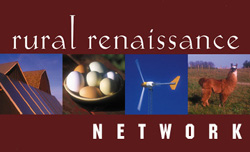| FACT SHEETAmerica's "rural renaissance" |  |
| FACT SHEETAmerica's "rural renaissance" |  |
The following summarizes some of the recent findings confirming a widespread demographic trend of individuals returning to the countryside or moving to rural areas from cities and suburbs. While there are rural counties that continue to experience a devastating decline, areas near urban centers or with rich scenic or amenity values are generally experiencing a widespread rebound in population. Decades of research by Dr. Kenneth Johnson at Loyola University in Chicago is invaluable in better understanding this rural migration, in particular his publication, The Rural Rebound: Recent Nonmetropilitan Demographic Trends in the United States, co-authored by Calvin Beale in 1999.
The Numbers
The long era of rural population stagnation and decline is now over.
- "Data from the 2000 Census reveal that nonmetropolitan [rural] areas of the United States contained 56.1 million residents, a gain of 5.6 million since April of 1990. In all, 1,702 of 2,303 nonmetropolitan counties grew between 1990 and 2000; 662 more than during the 1980s. Most of the growth came from net migration rather than from the natural increase (births-deaths) that has traditionally fueled nonmetropolitan growth." Source: The Rural Rebound: Recent Nonmetropilitan Demographic Trends in the United States by Kenneth Johnson and Calvin Beale, 1999.
- In the 1970s, the rural turnaround resulted in a "nonmetropolitan population gain that actually exceeded the gain in metropolitan areas for the first time in at least 150 years." Source: The Rural Rebound: Recent Nonmetropilitan Demographic Trends in the United States by Kenneth Johnson and Calvin Beale, 1999.
More families with children are choosing to raise kids in the country.
Small farmers and rural landowners can help restore ecological health and stability.
- "In the United States, small farmers devote 17 percent of their area to woodlands, compared to only five percent on large farms, and keep nearly twice as much of their land in "soil improving uses." Source: Institute for Food and Development Policy, Backgrounder, Winter 1999, Vol. 6, No. 4.
- "Approximately 40 percent of Oregon's farm and ranch acreage is owned by non-farmers who are renting or leasing the land back to farmers. The arrangement has helped keep nearly six million of Oregon's 15 million acres of agricultural land in production even though some 12,500 landowners figuratively never get on a tractor." Source: Oregon Department of Agriculture, August 22, 2001
Deconcentration, where people move from larger, more densely populated areas to smaller, more lightly settled areas, has made a rebound, not a reversal.
The resettling of rural America is by a diversity of people.
Moving rural is not a romantic fixation.
Rural America is important to the nation.